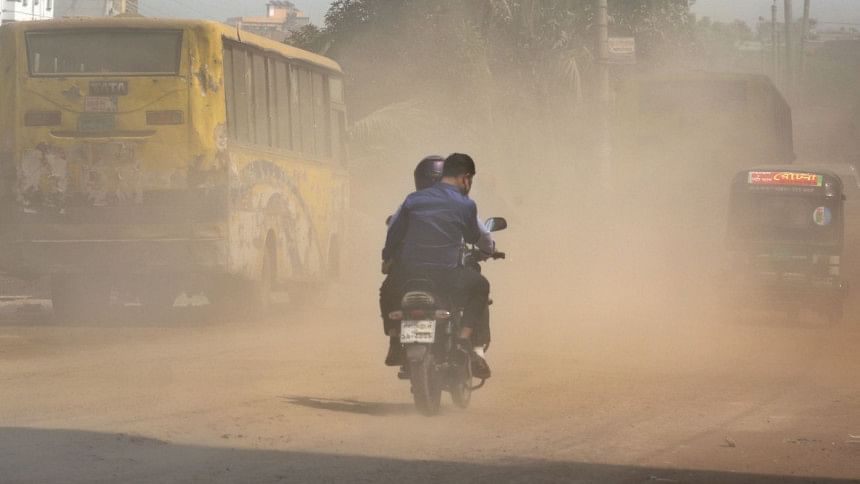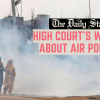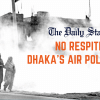Legislate Clean Air Act before it's too late!

Few months ago, Delhi had been declared as the most polluted city in the world. For most of us who breathed a sigh of relief, the breathing just got heavier. The smog caved in and before we knew it, Dhaka was already creeping up the list of the world's most polluted city.
Dhaka has been consecutively maintaining the highest position among the cities having the lowest air quality in the world. We are all so concerned about landfill, waste-waters, but very few of us actually consider air quality a major issue. Just like the water, the air is prone to be polluted leaving us at risk of contracting irreversible health problems. The US based Air Quality Index (AQI) provides a real time data on the air quality of every city in the world. It gives individual cities air quality scores ranging from 0-300+, associating it with the colour green on 0-50 (the cleanest) and maroon on 300+ (lowest air quality).
As decentralisation of Dhaka is not happening anytime soon, the risk of a major population being exposed to air pollution becomes inevitable. It is indeed sad to say, the city full of life has also been ranked as the second least liveable city in the world by The Global Liveability Index 2018.
The question is, what have we turned our habitat into? Was this what urbanisation had in store for us? Living in Dhaka comes with a hefty price, at the cost of money and a healthy life. There may be more chemicals in the air than all our laboratories combined. The toxicity in the air is slowly poisoning each of us, one day at a time.
Danger levels of the air are measured by using the volume of PM2.5. PM refers to "Particulate Matters" which are microscopic solid or liquid matter suspended in the air. The Department of Environment (DoE) under the Bangladesh government has found the presence of Sulphate, Nitrates, Ammonia, Sodium Chloride, Black Carbon and minerals in the air which are responsible for chronic respiratory diseases. These are suspended in the air often reaching dangerous levels, totally unfit for human inhalation. The DoE is therefore working to keep such pollution in check by operating Clean Air and Sustainable Environment (CASE). CASE publishes monthly reports and charts on air quality.
It also encourages people to abide by the rules in order to prevent such pollution to be created. It has undertaken several ambitious projects such as the National Ambient Air Quality Monitoring Programme, Brick Kilns Emission management and vehicular emission standards. But how much of these have visibly reduced air pollution? Our performance at the AQI is at a constant rate.
Air pollution in Bangladesh is at its peak in the dry seasons of October to March. The primary culprits behind this are the brick kilns and Dhaka's unbearable traffic congestion. Buses spewing black smoke still rule the roads despite having been banned years ago. Factories are being built around the outskirts of the capital. Altogether these sources contribute to the overall degradation of the air quality of this megacity.
The presence of hazardous substances in the air causes aggravation of asthma, heart and lung diseases. For example, according to M Khalequzzaman, "lead accumulates in body organs (i.e. brain), which may lead to poisoning or even death. The gastrointestinal tract, kidneys, and central nervous system are also affected by the presence of lead. Children exposed to lead are at risk of impaired development, lower IQ, shortened attention span, hyperactivity, and mental deterioration." If this goes on, it wouldn't come as much of a surprise to see a future generation full of health issues.
What does the law say?
The Bangladesh Environment Protection Act 1995 puts a restriction on the driving of vehicles producing smoke harmful to the environment. It even imposes a punishment of imprisonment for a term which may extend to five years or with a fine which may extend to Tk 1 lakh, or with both. However, the presence of these black smoke emitting buses still bustling clearly goes to show how well the Act has been implemented. In 2013 the government passed the Brick Manufacturing and Brick Kilns Establishment (Control) Act. This ordered Brick Kilns companies to "convert" the kilns into modern technology within two years' time. However, it was not realistically possible to do so in the stipulated time limit. Hence it can be said that there isn't any law at the moment that can control the air pollution in Dhaka.
Although it cannot be totally removed, the focus now should be on air quality management on the existing environmental laws of Bangladesh. The government took the initiative to draft a "Clean Air Act" back in 2018 through a workshop on its formulation. The organisers, Ministry of Environment, Forest and Climate Change, the DoE, Bangladesh Environmental Lawyers Association, however, were doubtful whether such an Act can rightfully be implemented. The rule violators would break it just like any other laws. Therefore, imposing a strict liability is the only way to ensure cleaner air. The Act would need further push from the Ministry and DoE in order to be enacted. If that doesn't happen, the previous Acts would need greater amendment.
The air we breathe in is vital to life. The concern would not have been so grave if our bodies did not require oxygen. We have certainly taken our respiratory system for granted since it seems to work fine. We don't realise our mistakes until it is too late. It should be the top priority of the government at the moment to do something about the air pollution. Our lives are at risk and this needs prompt action.
Aiman R Khan is an Advocate, Dhaka Judge Court.










Comments